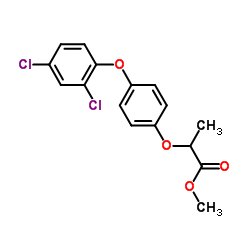DICLOFOP-METHYL

DICLOFOP-METHYL structure
|
Common Name | DICLOFOP-METHYL | ||
|---|---|---|---|---|
| CAS Number | 51338-27-3 | Molecular Weight | 341.186 | |
| Density | 1.3±0.1 g/cm3 | Boiling Point | 408.0±45.0 °C at 760 mmHg | |
| Molecular Formula | C16H14Cl2O4 | Melting Point | 39-41°C | |
| MSDS | Chinese USA | Flash Point | 150.3±27.7 °C | |
| Symbol |


GHS07, GHS09 |
Signal Word | Warning | |
|
Characterisation of target-site resistance to ACCase-inhibiting herbicides in the weed Alopecurus myosuroides (black-grass).
Pest Manag. Sci. 59(2) , 190-201, (2003) Resistance to aryloxyphenoxypropionate (AOPP), cyclohexanedione (CHD) and phenylurea herbicides was determined in UK populations of Alopecurus myosuroides Huds. Two populations (Oxford AA1, Notts. A1) were highly resistant (Resistance indices 13-->1000) to th... |
|
|
Genetic control of a cytochrome P450 metabolism-based herbicide resistance mechanism in Lolium rigidum.
Heredity (Edinb.) 106(5) , 817-24, (2011) The dynamics of herbicide resistance evolution in plants are influenced by many factors, especially the biochemical and genetic basis of resistance. Herbicide resistance can be endowed by enhanced rates of herbicide metabolism because of the activity of cytoc... |
|
|
Recurrent selection with reduced herbicide rates results in the rapid evolution of herbicide resistance in Lolium rigidum.
Theor. Appl. Genet. 110(6) , 1154-66, (2005) There has been much debate regarding the potential for reduced rates of herbicide application to accelerate evolution of herbicide resistance. We report a series of experiments that demonstrate the potential for reduced rates of the acetyl-co enzyme A carboxy... |
|
|
Time-dependent degradation and toxicity of diclofop-methyl in algal suspensions : emerging contaminants.
Environ. Sci. Pollut. Res. Int. 16(4) , 459-65, (2009) As emerging contaminants, transformation products of the pollutants via various environmental processes are rather unknown, and some may predominantly contribute to the environmental risks of the parent compounds. Hence, studies on transformation products com... |
|
|
Environmental effects of inclusion complexation between methylated beta-cyclodextrin and diclofop-methyl.
J. Agric. Food Chem. 53(17) , 6744-9, (2005) Diclofop-methyl (DM) is a broad-spectrum herbicide but often shows a reduced biological activity against the target grasses due to its poor water solubility and slow translocation within plant tissues. Randomly methylated beta-cyclodextrin (MCD) is an effecti... |
|
|
Relation of diclofop-methyl toxicity and degradation in algae cultures.
Environ. Toxicol. Chem. 26(5) , 970-5, (2007) Information on the effects of pesticide degradation on aquatic organisms is needed to properly evaluate the ecotoxicity arising from the use of pesticides and for aquatic risk assessment. This work evaluated the toxicity of diclofop-methyl (DM) and its two ma... |
|
|
Tank-mix adjuvants and pesticide residues: some regulatory and quantitative aspects.
Pest Manag. Sci. 59(11) , 1237-44, (2003) Although it is well known that judicious use of adjuvants can increase the performance of foliage-applied sprays of many agrochemicals, little information is available in the public domain about their ultimate effects on pesticide residues in treated crops. I... |
|
|
Herbicide selection of Italian ryegrass under different levels of UVB radiation.
J. Environ. Qual. 33(4) , 1376-86, (2004) Ultraviolet-B radiation is an environmental stress for plants and this situation could become aggravated in the next decades. In this study we used Italian ryegrass (Lolium multiflorum Lam.) as a model system to test whether an environmental stress derived fr... |
|
|
Bioluminescence determination of enzyme activity of firefly luciferase in the presence of pesticides.
Luminescence 20(3) , 192-6, (2005) Firefly luciferase (EC 1.13.12.5) (FL) is the key enzyme in the firefly bioluminescence method (FB), which is widely used to determine the viability of living cells. The FB method can also be applied to monitoring the influence of different pollutants, such a... |
|
|
Genotoxic effects of chlorophenoxy herbicide diclofop-methyl in mice in vivo and in human lymphocytes in vitro.
Drug Chem. Toxicol. 34(4) , 390-5, (2011) Diclofop-methyl (DM) is a chlorophenoxy derivative used in large quantities for the control of annual grasses in grain and vegetable crops. In this study, the genotoxic effects of DM were investigated by measuring chromosomal aberrations (CAs) in mouse bone-m... |